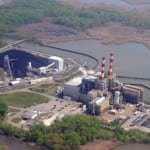Employees at the 293-MW Muscatine Power & Water plant combine a positive attitude with an aggressive focus on workplace safety, inspired by the motto: “We all can adapt, adopt, and improve to meet the challenges head on to provide our customers with reliable power.” The facility began using Powder River Basin coal in 1993, and the staff have learned effective techniques to use it safely.
Headquartered in Muscatine, Iowa, on the Mississippi River, Muscatine Power & Water (MP&W) provides electricity, water, and communications products and services to a 24-square-mile service area (Figure 1). MP&W is the largest municipally owned utility in the state in terms of generating capacity and revenue. Established in 1922, the MP&W electric utility has a service area of 22,719 residents and 11,204 electric customers. This year, its operational practices made it an award-winner.
 |
| 1. Energizing Iowa. A nighttime view of the Muscatine Power & Water (MP&W) plant located on the Mississippi River in southeastern Iowa. Established in 1922, MP&W is the largest municipally owned utility in the state in terms of generating capacity and revenue. Courtesy: MP&W |
The Powder River Basin Coal Users’ Group (PRBCUG) conducted its annual meeting in conjunction with the 2011 ELECTRIC POWER Conference & Exhibition in May 2011. Each year the PRBCUG recognizes two PRBCUG Coal Plants of the Year (Large and Small Plant categories) for their innovation and implementation of “best practices and best available technologies.” The Large Coal Plant of the Year award went to Kansas City Power & Light’s Iatan Unit 2, coincidentally the 2011 POWER Plant of the Year (see our August 2011 issue or the archives at https://www.powermag.com). The Small Plant Award went to the MP&W plant (Figure 2).
 |
| 2. A powerful team. The main reasons for the plant’s success: the employees of Muscatine Power & Water plant. Shown from left to right are Jeff Hedrington, safety manager; Ray Danz, director of power production and supply; Mike Avesing, plant manager; Scott Clester, material handling supervisor; Mark Costello, maintenance supervisor; and Greg Krieser, past chair of the PRBCUG Board of Directors. The photo was taken in May 2011 at the ELECTRIC POWER Awards Banquet. Source: POWER |
Both winning plants each year are inducted into the PRBCUG’s Power Plant Hall of Fame. Selections are made by the board, with input from the group’s members. PRBCUG membership consists of users and prospective users of PRB coals (generating companies or industrial energy consumers). Associate members from companies supplying coal, equipment, or services also participate in the selection process.
In November, Greg Krieser, past chair of the PRBCUG Board of Directors, told POWER why the MP&W plant is viewed as being an industry leader in handling PRB coal. “The story of the City of Muscatine’s MP&W plant embodies the principles of the Powder River Basin Coal Users’ Group,” Kreiser said. “They learned from the experience of others, and they shared their experiences for the benefit of others. Our group wants to thank Mark Costello, the MP&W maintenance supervisor, and his staff for implementing the best practices for safe and efficient use of PRB coal.”
Facility Overview
The MP&W facility consists of three main generation units: Units 7, 8/8A, and 9. In 2010, the units produced a combined total of 1,128 GWh of electricity.
The units have the following profiles:
- Unit 7 began commercial operation in 1958. It has a Wickes stoker-fired boiler and a 25-MW GE turbine generator.
- Unit 8 began commercial operation in 1968. It has a Babcock & Wilcox (B&W) cyclone-fired boiler and a 75-MW GE turbine generator.
- Unit 8A began commercial operation in 2000. It has an 18.05-MW noncondensing Mitsubishi turbine with an Alstom generator. Steam for Unit 8A is supplied from Unit 8’s boiler. Exhaust steam from the unit’s turbine is used to supply a local grain processing facility with steam from two reboilers that flash condensate from the grain company back into process steam for use at the grain processing facility.
- Unit 9 began commercial operation in 1983. It has a Combustion Engineering (now Alstom Power) T-fired pulverized boiler and a 175-MW GE turbine generator.
During 2010, the units delivered the following performance numbers:
- Unit 7, which experienced 2.52 unplanned outage hours and 2.52 forced outage hours, had a 99.97% availability factor and a 71.82% service factor.
- Unit 8, which experienced 760.67 unplanned outage hours and 525.9 forced outage hours, had an 84.42% availability factor and a 43.72% service factor.
- Unit 8A, which experienced 372.93 unplanned outage hours and 134.52 forced outage hours, had an 88.88% availability factor and an 88.88% service factor.
- Unit 9, which experienced 43.86 unplanned outage hours and 3.28 forced outage hours, had a 99.49% availability factor and a 94.08% service factor.
Currently, 130 employees work at the plant and handle operations, maintenance, technical, electrical, material handling, supply chain services, and environmental services.
Making the Switch to PRB Coal
Southern Illinois bituminous coal was used in all three boilers prior to switching to PRB coal, Costello explained. PRB coal comes mostly from Wyoming and Montana. Readers of this magazine are by now familiar with the primary characteristics of PRB coal: It is low in sulfur and heat content, and very volatile if not properly handled and stored. Costello said that the MP&W staff “tried multiple PRB test coals, including Eagle Butte, Jacobs Ranch, Black Thunder, and Antelope coal, and now burn coal from the Buckskin and Black Thunder coal mines” (Figure 3). No coal is blended.
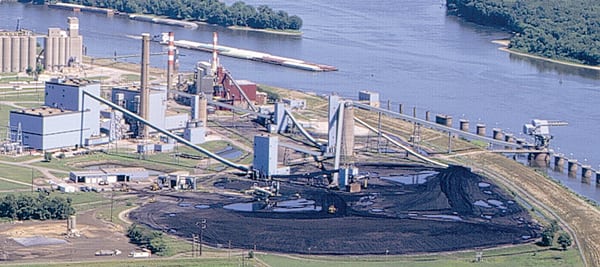 |
| 3. Final destination. The Muscatine Power & Water plant owns two trains that deliver PRB coal from Wyoming. Once the coal arrives at the plant, it is processed through a bottom dump rail facility and stockpiled in the coal yard. The largest blue building shown in the photo is Unit 9; the red buildings are Units 7, 8, and 8A. The material handling buildings are also blue. Courtesy: MP&W |
At the MP&W plant, it took approximately a year from start to finish to carry out the initial switch to PRB coal. Leading the conversion process, Unit 9 converted in 1993.
“Unit 9 was unique in that it was originally designed to burn PRB coal and converted to bituminous coal during construction in 1982,” Costello said. “So when we converted to PRB coal in 1993 the challenges were minimal.”
Conversion to PRB coal in Units 7 and 8 started in 1998, and both conversions were completed in 1999. Now all MP&W units burn 100% PRB coal.
“Units 7 and 8 switched to PRB coal in 1999 with a pretty rough start right out of the gate,” Costello said. “This was a much more difficult task at these older units because they had never been intended to burn PRB coal. The results from these conversion attempts showed our shortcomings in the fall of 1999 when we blew the roofs off both these units as a result of primary and secondary explosions in our bunker galleries” (Figures 4 and 5). Fortunately, no one was hurt by these explosions.
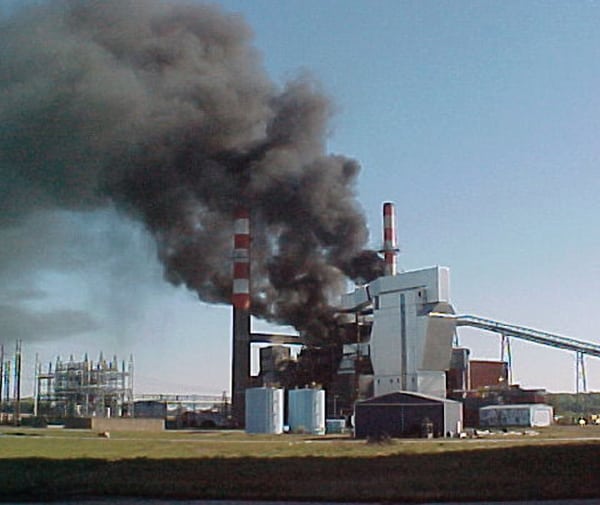 |
| 4. An explosive situation. The explosion and fire that occurred at the Muscatine Power & Water plant in September 1999 was an “eye-opening experience” that motivated plant personnel to learn about the safe handling of PRB coal. Courtesy: MP&W |
 |
| 5. Hard lesson learned. The explosion that blew the roofs off Units 7 and 8 was caused by primary and secondary explosions in the bunker galleries, shortly after the conversion to PRB coal was completed. Fortunately, no one was hurt as a result of the explosions. Courtesy: MP&W |
Worker Safety: A Paramount Concern
“After our explosion/fire in 1999, our management made the commitment to learn everything possible about PRB coal and the safe handling of the coal,” Costello said. “Many resources were utilized—from contacting other power plants to boiler manufacturers. Ultimately, these contacts led us to the PRB Coal Users’ Group, which we have been a member of since 2001, and we have implemented many of the best practices learned from the annual user group meetings.”
MP&W made the following changes to its regular fire hazard inspections due to the increased volatility of PRB coal:
- Hotwork procedures were developed.
- Fire systems were either upgraded or new systems were installed in critical areas.
- CO2 inerting systems and aqueous film-forming foam systems were installed.
Smoke detection systems were installed in electrical rooms.
Costello pointed out that “$3.7 million was invested to upgrade all of our areas where we were deficient in regard to fire protection systems.” In addition, predictive maintenance schedules had to be set up to meet all the testing criteria of the new systems.
Overcoming Fuel-Handling Challenges
After the initial “rough start” with Units 7 and 8, the MP&W staff instituted a rigorous process to incorporate the best practices and technologies in the industry to minimize problems related to the use of PRB coal. Costello noted that the three units each had a different type of combustion technology, which presented unique operating challenges.
In 1999 when the MP&W staff began converting Units 7 and 8, they had Tim Korrs, a B&W representative, come to the plant and do airflow calculations on the total, secondary, and primary airflows. As a result of Korrs’ findings, the staff reduced the primary air orifice in the duct to allow them to run the damper farther open to help them control primary air better. Costello said that Korrs “helped us fine-tune our controls and switched us over from boiler O2 control to fuel/air ratio control, which helped us tremendously.”
“Our cyclone-fired boiler was probably the most challenging, with it having a small fire box and being a pressurized unit,” he said. “We added Diamond Power Hydro-Jets to Unit 9 for additional wall-cleaning capabilities and a water lance to Unit 8 for additional upper furnace/screen tube cleaning.”
On the “B” cyclone in Unit 8, the primary air duct was flush in the secondary air duct. The MP&W staff had trouble with airflow balance and then made an elbow on the primary air duct so that it actually scoops the air out of the secondary air stream. This modification has also helped them to achieve a good airflow balance.
Costello added that it takes constant monitoring with visual boiler inspections by the operators to keep the boilers operating efficiently and to prevent any tapping problems.
“Coal tonnage through the cyclone is a big issue,” he said. “If we can keep it in the 14 tons/hour range we can do pretty well without gas pilots. It’s when we get above that level and most definitely up in the 17-ton range that pilots are needed, especially if burning wet coal or coal that has been on the stockpile for a while and has lost Btus.”
During the spring 2005 outage, the cyclone casings were re-skinned. Costello explained that this action was taken because “we had been experiencing a lot of burn thrown on the cyclone skins.” The MP&W staff also increased the horse power on the drive motors in the material handling area so the additional coal tonnage could be fed to the plant.
Dealing with Dust
“Dust control was one of our biggest challenges,” he said. “We took a six-phase approach with dust improvement projects totaling $5.7 million, which were started in 2001 and completed in 2009. Multiple technologies where utilized in all areas of the plant’s material-handling systems.”
Costello explained that after the plant’s initial changeover to PRB coal, it took several additional years to implement all of the improvement projects, from fire protection to coal-handling chute modifications and replacements. Other changes involved managing a larger coal pile, adding dust collectors and dust suppression systems, and replacing belt skirtings (Figure 6).
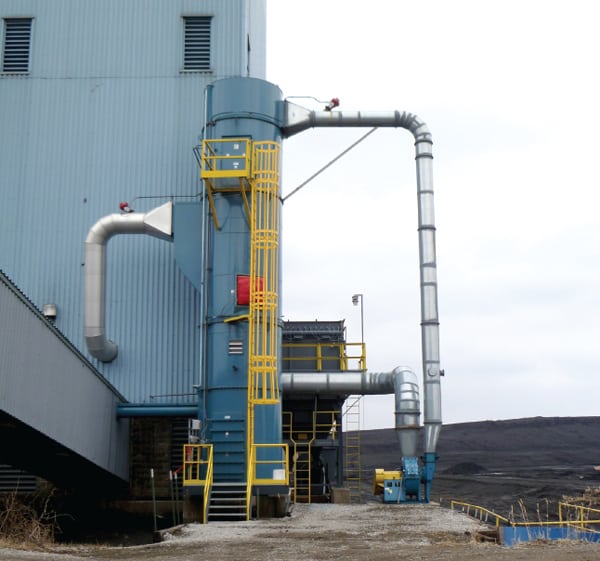 |
| 6. New dust busters. As part of MP&W’s $5.7 million dust improvement project, more advanced dust collectors and dustless transfer chutes were added, which eliminated the need for several older model dust collectors. Courtesy: MP&W |
Costello also said that the plant had to make significant changes to its regular housekeeping duties as a result of the switch to PRB coal. He emphasized that the staff “cannot leave any coal dust lying around or accumulating near coal conveying rollers because PRB coal will self-ignite if exposed to any heat source.” Conveyor rooms are washed and swept daily. As part of the plant’s current cleaning regimen, the operations staff have assigned cleaning areas throughout the plants.
“Bunker rooms and coal handling out buildings were not originally designed for washdown,” he said. “Through the conversion process, all areas are now hosed down daily and monitored.”
During any outage in which coal is left in the bunkers, the bunkers are filled and inerted with CO2. As a standard operating procedure, the MP&W staff does not leave coal in the bunkers any longer than five days. Costello said that “the coal is also monitored daily with a laser temperature gun for hotspots along with visual inspections.” All bunker doors are kept closed as well.
Creating a Culture of Achievement
Costello listed the reasons why he thinks the Muscatine employees are so successful at carrying out the dual imperatives of efficient plant operations and workplace safety:
- Aggressive cleaning schedules at the plant.
- Use of technology to prevent dust accumulation.
- Development of a comprehensive combustible dust management program.
- Development and implementation of the National Fire Protection Association’s 70E standard for electrical safety in the workplace (Figure 7).
- Positive attitudes of all the employees.
- Overall pride in the plant, evidenced by the close-knit employees, who typically are friends, family, and neighbors.
- A safety culture second to none.
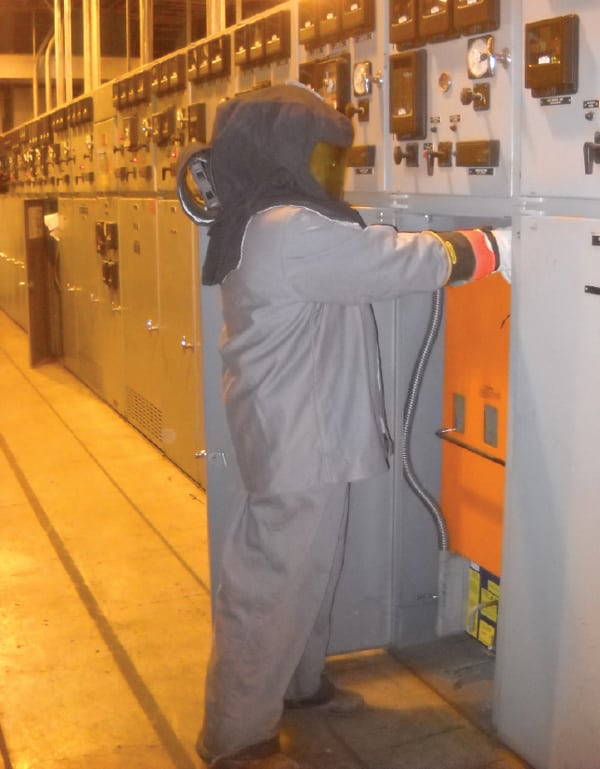 |
| 7. Protection against electrical hazards. The MP&W staff identified all of their electrical equipment hazards and developed the facility’s 70E Electrical Protection Program. The use of decals helps to identify the personnel protective equipment needed to safely rack out plant equipment. The staff also went through the plant and reduced as many arc flash areas as possible to lower levels, wherever applicable. Courtesy: MP&W |
Leading by Example
POWER congratulates the management and staff of the Muscatine Power & Water plant for being named the 2011 PRBCUG Small Coal Plant of the Year. As more facilities follow the example set by award-winning facilities like the MP&W plant, the trend toward smarter ways of handling jobsite risks should produce positive, long-lasting results for workplace safety.
For further information on the MP&W plant or the plant’s improvement projects, please contact Mark Costello, maintenance supervisor, at 563-262-3503 or mcostell@mpw.org. Additional information on the PRBCUG and its awards program is available at http://www.prbcoals.com.
— Angela Neville, JD is POWER’s senior editor.










